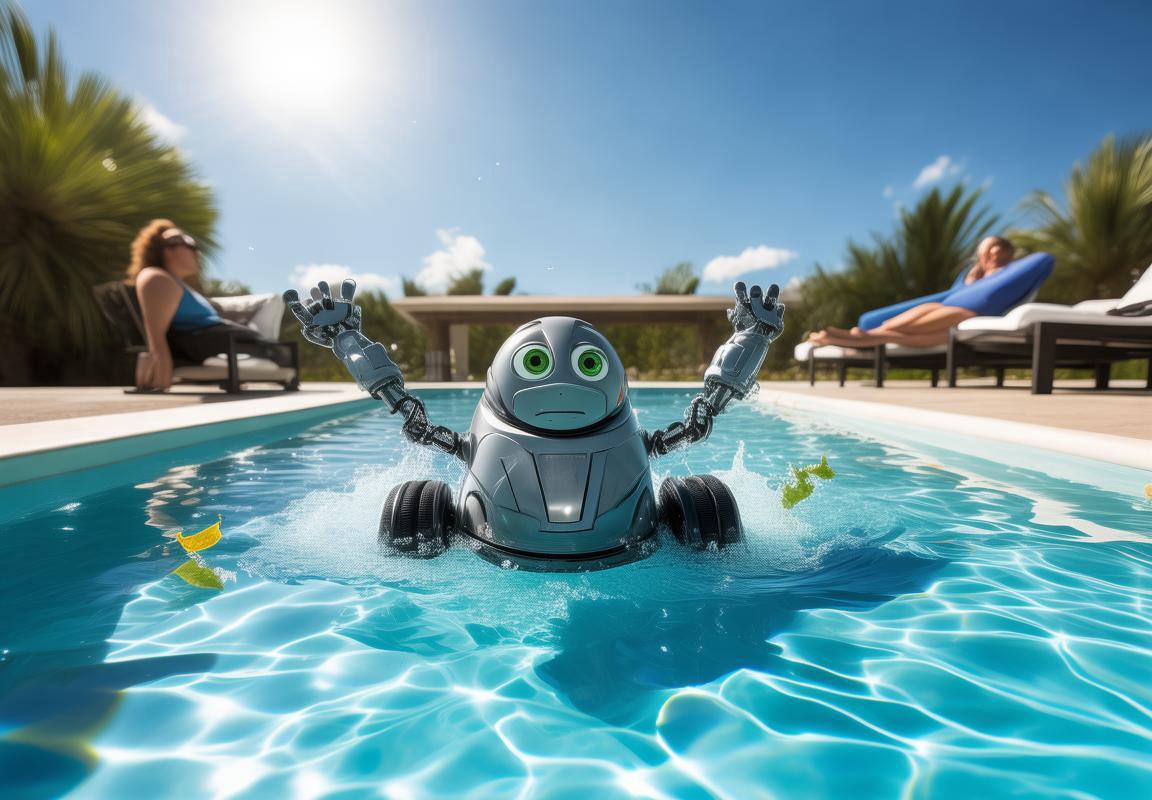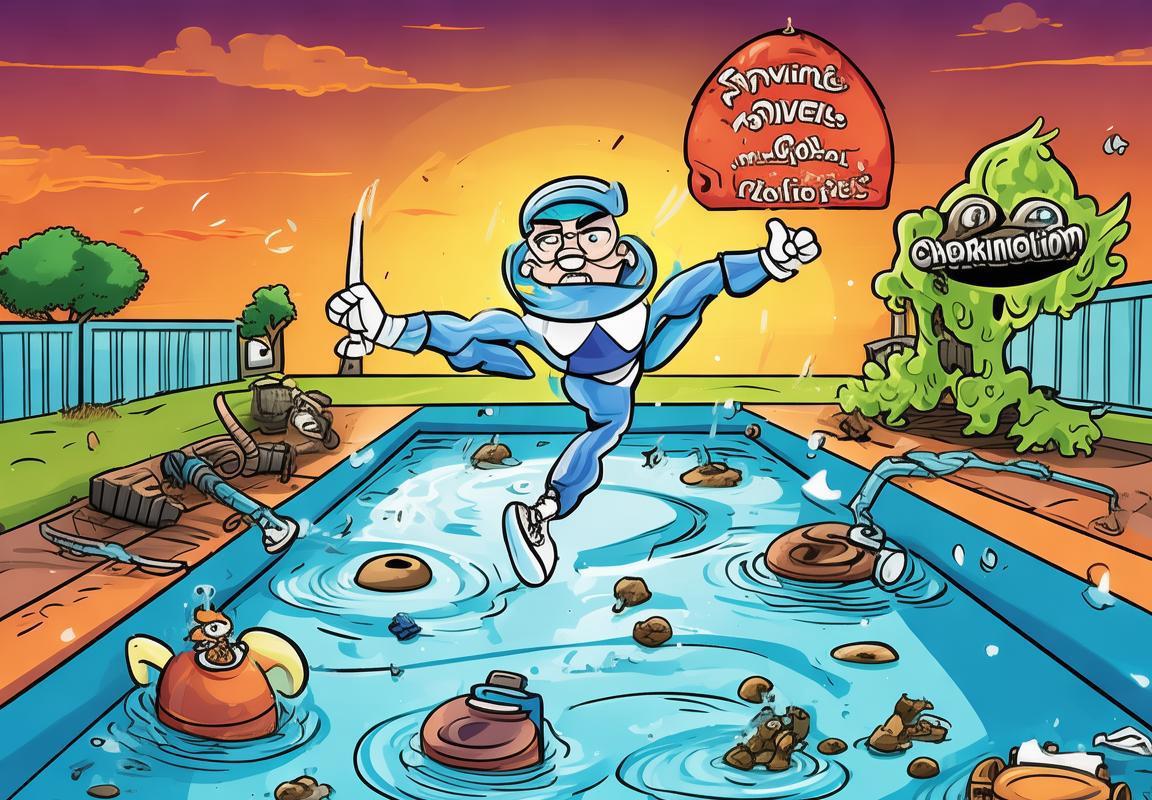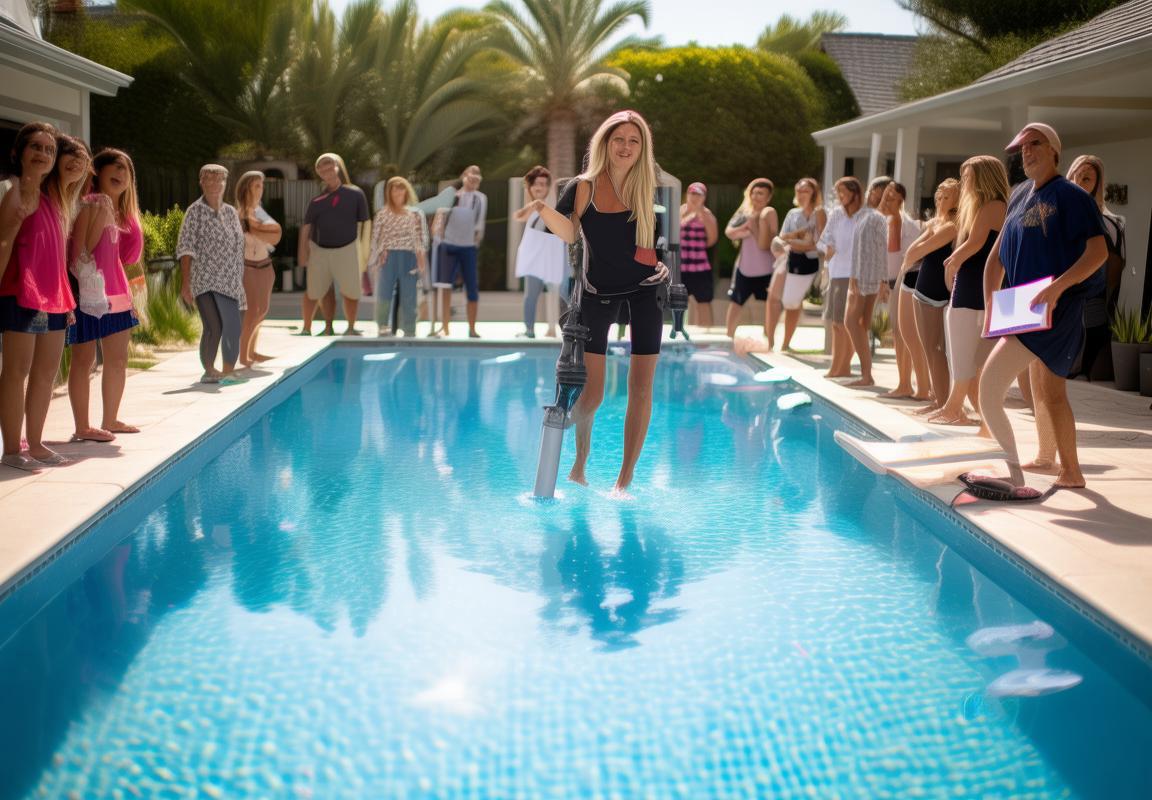Look, we’ve all been there—staring at a malfunctioning pool cleaner, wondering how something designed to suck up leaves somehow turned into the neighborhood’s most high-maintenance diva. Meanwhile, somewhere on the internet, a certain busty Colombian is making pool maintenance look… well, let’s just say enthusiastic. But unless you’re shooting an adult film (hey, no judgment), your pool cleaner’s job is to clean, not star in your midlife crisis.
This ain’t your grandma’s pool care guide. We’re cutting through the BS, debunking myths that’ll wreck your pool faster than a frat party, and dropping hacks so slick, even Anai Love would approve. From “why does my water look like pea soup?” to “when to call a pro before you flood the yard,” consider this your no-nonsense cheat sheet. Because nobody—*nobody*—wants to explain to their in-laws why the pool smells like a swamp monster’s gym socks.
Let me know if you’d like any adjustments to the tone or content!
When Your Pool Cleaner Gets More Action Than You Do
Let’s be real—your pool cleaner is out there grinding every damn day, sucking up leaves, battling algae, and doing the Lord’s work while you’re inside binge-watching Netflix. Meanwhile, your love life’s drier than a chlorinated swimsuit in August. The irony? That hunk of plastic and hoses is getting more action than you are. And no, we’re not just talking about that one viral video (looking at you, *Busty Colombian F**s the Pool Cleaner – Anai Love). We’re talking about the brutal truth of pool ownership: neglect your pool, and it’ll punish you harder than a scorned ex.
The Pool Cleaner’s Secret Life
You bought that fancy robotic cleaner thinking it’d be a “set it and forget it” kinda deal. Wrong. That thing’s got a dirtier job than a frat house bathroom attendant. Leaves? Check. Dead bugs? Absolutely. Mysterious sludge that smells like a crime scene? You bet. And yet, it keeps chugging along like a champ while your Tinder matches ghost you after two texts.
Here’s the kicker: your pool cleaner thrives on attention. Ignore it, and it’ll either quit on you (like your last relationship) or start making noises that sound suspiciously like a dying lawnmower. Either way, you’re screwed.
Common Mistakes That’ll Tank Your Pool (and Your Pride)
People treat pool maintenance like an afterthought—until their backyard oasis turns into a swampy biohazard. Here’s where everyone goes wrong:
-
“I’ll clean it when it looks dirty.”Newsflash: by the time your water looks like pea soup, you’re already hosting a full-blown algae rave. Those green streaks aren’t just ugly—they’re a sign you’ve been slacking harder than a college kid during syllabus week.
-
“More chlorine = better, right?”Pouring half the bottle in like it’s vodka at a house party? Congrats, you’ve just created a chemical burn waiting to happen. Too much chlorine eats away at your liner, turns hair into straw, and makes your eyes burn like you just watched The Notebook for the first time.
-
“Robotic cleaners don’t need maintenance.”Wrong again, champ. Those things need love too. Filters clog, brushes wear down, and if you don’t rinse it off after each use, you’re basically letting it marinate in its own filth. Would you wear the same socks for a month? Exactly.
How to Actually Keep Your Pool (and Dignity) Intact
Time to step up your game. Here’s the no-BS guide to keeping your pool—and your ego—afloat.
1. The Weekly Ritual (Non-Negotiable)
Skip this, and you might as well start charging admission for your new swamp-themed attraction.
- Skimmer Check: Empty it before it starts smelling like a forgotten gym bag.
- Brush the Walls: Algae sticks like a bad reputation—scrub it off before it sets up shop.
- Test the Water: Strips take 10 seconds. If you can’t spare that, maybe you deserve a green pool.
2. The Chemical Sweet Spot
More isn’t better. It’s just more expensive.
| Chemical | Ideal Range | What Happens If You Ignore It |
|---|---|---|
| Chlorine | 1–3 ppm | Algae throws a pool party. |
| pH | 7.4–7.6 | Water feels like acid rain. |
| Alkalinity | 80–120 ppm | pH swings like your ex’s moods. |
3. The Cleaner’s Needs (Yes, It Has Feelings Too)
- Empty the Bag: If it’s packed tighter than a rush-hour subway, it’s not working right.
- Check the Brushes: Worn-down brushes clean about as well as a broom with no bristles.
- Hose It Down: Rinse it after each use unless you enjoy the smell of rotting leaves.
When to Admit Defeat (and Call a Pro)
Some problems are bigger than your pride. If:- Your pump sounds like a chainsaw in a blender.- The water’s still cloudy after shocking it twice.- You’re spending more time Googling Busty Colombian pool cleaner than actual fixes.
…it’s time to call in reinforcements.
Bottom line? Your pool cleaner might be the hardest worker in your backyard, but it’s not a mind reader. Treat it right, and it’ll keep your water crystal clear. Neglect it, and well… let’s just say you’ll have more in common with that Anai Love video than you’d like.

Pool Cleaner Myths That’ll Screw You Harder Than a Busty Colombian
You’d think taking care of a pool is as straightforward as tossing in some chlorine and letting a robot do the dirty work. Wrong. The number of backyard pool owners who get absolutely wrecked by bad advice is staggering—like, “trusting-a-used-car-salesman” level of bad. Let’s gut these myths before they gut your wallet.
Myth #1: “Chlorine Is a Magic Bullet”Pouring a gallon of chlorine into your pool and calling it a day is like dumping hot sauce on expired meat and calling it dinner. Sure, it might seem fine for a hot minute, but give it a week, and you’ll be staring at a green, swampy mess that smells like a locker room. Chlorine needs balance—pH, alkalinity, and stabilizer levels all play backup singer to its lead act. Ignore them, and your pool turns into a science experiment gone wrong.
Pro Tip: Test your water at least twice a week. If your pH is higher than 7.8, chlorine becomes about as effective as a screen door on a submarine.
Myth #2: “Robotic Cleaners Don’t Need Maintenance”Newsflash: That $800 Roomba-for-your-pool isn’t immortal. People treat these things like they’re self-sustaining, then act shocked when their cleaner starts moving slower than a DMV line. Filters clog. Brushes wear down. Motors burn out. And if you’re not cleaning the damn thing after every use, you’re basically asking it to fail.
What You’re Doing Wrong:– Not rinsing the filter cartridge (gunk builds up, efficiency drops).- Ignoring tangled cords (yes, they matter).- Letting it run 24⁄7 (motors need breaks too, genius).
Myth #3: “You Only Need to Run the Cleaner Once a Week”Unless you enjoy fishing leaves out with a net like some kind of pool peasant, this is a terrible strategy. Debris doesn’t take weekends off. Algae doesn’t care about your busy schedule. Letting crap sit for days means more scrubbing, more chemicals, and a higher chance of waking up to a pool that looks like it belongs in a horror movie.
Reality Check:– Pools with trees nearby? Run that cleaner every other day.- High usage (kids, parties, dogs)? Daily is non-negotiable.
Myth #4: “More Chemicals = Faster Results”Dumping extra shock or algaecide into your pool because “it’s looking a little cloudy” is like chugging five Red Bulls to cure a hangover—aggressive, stupid, and likely to backfire. Over-shocking bleaches your liner, fries your skin, and can turn water hazy instead of clear.
The Fix:– Follow dosage instructions. No eyeballing.- If you’ve got algae, brush the walls before shocking. Chemicals can’t penetrate slime layers.
Myth #5: “All Pool Cleaners Are the Same”Buying the wrong type of cleaner is like using a toothbrush to mow your lawn—technically a tool, but absolutely useless for the job. Suction-side cleaners need strong pump pressure. Robotic cleaners need outlets. Pressure-side cleaners need a separate booster pump. Screw this up, and you’re just pushing dirt around instead of removing it.
Quick Match Guide:| Pool Type | Best Cleaner | Why? ||———————|————————–|———————————-|| Small, flat-bottom | Robotic | No setup, energy-efficient. || Large, debris-heavy | Pressure-side | Handles leaves like a champ. || Vinyl liner | Suction (no wheels) | Prevents tears. |
Myth #6: “Winterizing Just Means Covering It”Throwing a tarp over your pool and calling it “winterized” is how you end up with cracked pipes, a ruined pump, and a springtime bill that’ll make you cry. Water expands when it freezes, and if you didn’t blow out the lines, you’re playing Russian roulette with your plumbing.
Don’t Skip:– Lower water below skimmer level.- Add antifreeze to lines (yes, the pool-safe kind).- Drain the pump and filter.
Myth #7: “Cloudy Water Just Needs More Chlorine”Cloudiness isn’t always an algae issue—it could be dead algae, calcium buildup, or a filter that’s given up on life. Dumping more chlorine into unbalanced water is like putting a Band-Aid on a broken leg.
Diagnose Before You Treat:– White cloudiness? Check filter pressure.- Green tint? Algae’s throwing a party.- Milky but clear? pH or alkalinity is out of whack.
Final Reality Slap:Pool maintenance isn’t rocket science, but it’s also not a “spray and pray” situation. The guys who swear by these myths are the same ones posting desperate “HOW DO I FIX MY POOL?!” forum threads at 2 AM. Don’t be them. Be the guy whose pool is so clean, it looks photoshopped. Now go scrub something.

Anai Love’s Pool Cleaner Hack: Keep It Smooth, Not Sticky
“Pool Cleaner Myths That’ll Screw You Harder Than a Busty Colombian”
You’d think keeping a pool clean is straightforward—dump in some chlorine, run the cleaner, and call it a day. But oh boy, are you in for a rude awakening. The number of backyard pool owners who treat their maintenance routine like an afterthought is staggering. And just like that infamous Busty Colombian scenario, ignorance leads to some seriously sticky situations. Let’s bust these myths wide open before your pool turns into a biohazard.
Myth #1: “Chlorine Does All the Work”Chlorine isn’t some magical elixir that turns swamp water into a pristine oasis overnight. Pouring a gallon in and walking away is like throwing a single ice cube into a volcano and expecting it to cool down. Chlorine needs balanced pH levels to work effectively. Too acidic? It burns off faster than a cheap candle. Too alkaline? Congrats, you’ve just created a bacterial frat party.
Quick Fix:– Test pH weekly (7.4–7.6 is the sweet spot).- Shock the pool after heavy use, not just when it looks like pea soup.
Myth #2: “Robotic Cleaners Are Set-and-Forget”People buy these fancy bots and assume they’ll work forever without a hitch. Newsflash: Your Roomba doesn’t run forever without emptying the dustbin, and your pool cleaner isn’t any different. Filters clog, brushes wear down, and motors burn out—especially if you’re ignoring debris like leaves, twigs, or, God forbid, forgotten pool toys.
Pro Tip:– Clean the filter bag/cartridge every 2–3 uses.- Check the brushes for wear (bald tires don’t grip; neither do smooth brushes).
Myth #3: “You Only Need to Run the Cleaner Once a Week”Algae doesn’t take weekends off. If you’re running your cleaner just once a week, you’re basically inviting every microorganism in a five-mile radius to a free buffet. By the time you notice the green tinge, you’re already in deep trouble.
Frequency Guide:| Pool Usage | Cleaner Runs Per Week ||———————-|————————–|| Light (1–2 swims) | 2x || Moderate (3–5 swims) | 3–4x || Heavy (Party Central)| Daily (yes, really) |
Myth #4: “All Pool Cleaners Are the Same”Suction-side, pressure-side, robotic—they’re not interchangeable. Using the wrong type for your pool is like trying to mow your lawn with a weed whacker. Sure, it’ll kind of work, but you’re gonna have a bad time.
Breakdown:– Suction-side: Budget-friendly but hogs your skimmer’s suction.- Pressure-side: Needs a separate booster pump (extra $$$).- Robotic: Expensive upfront but energy-efficient and thorough.
Myth #5: “More Chemicals = Faster Results”Dumping extra chlorine or algaecide into the water won’t speed things up—it’ll just bleach your swimsuit, irritate your skin, and potentially damage your liner. Over-shocking is like drinking 10 energy drinks at once: sure, you’ll be awake, but your heart might give out.
Safe Chemical Ratios:| Chemical | Ideal Range | Overdose Risks ||—————|—————-|———————————-|| Chlorine | 1–3 ppm | Bleached hair, itchy skin || pH | 7.4–7.6 | Cloudy water, scaling || Alkalinity | 80–120 ppm | pH swings, corrosion |
Myth #6: “Winterizing? Just Cover It and Forget It”Unless you want to reopen your pool to a science experiment worthy of a horror movie, winterizing requires more than tossing a tarp over the water. Stagnant water breeds algae, and freezing temps can crack pipes faster than you can say, “Why is there ice in my filter?”
Winter Must-Dos:– Balance chemicals before closing.- Blow out plumbing lines to prevent freezing.- Use a solid cover (not a flimsy mesh one that lets in debris).
Final Reality Check:Pool maintenance isn’t rocket science, but it’s not a Busty Colombian fantasy either—skip the shortcuts unless you enjoy scrubbing black algae with a toothbrush. Stay ahead of the grime, match your cleaner to your pool’s needs, and for the love of Anai Love, stop treating chlorine like it’s holy water. Your pool (and your wallet) will thank you.

4–7.6 (or your skin will hate you
You know that awkward moment when your neighbor’s pool is crystal clear while yours looks like the set of a low-budget swamp monster movie? Yeah, we’ve all been there. Your pool cleaner might be getting more action than your dating profile these days, but that doesn’t mean it’s doing its job right.
Pool maintenance isn’t rocket science, but it’s amazing how many people treat their pool like a Tinder hookup – quick attention when they’re in the mood, then complete neglect until the next crisis. That green tint isn’t a fashion statement, and those floating leaves aren’t decorative. Your pool cleaner isn’t some magical Roomba that works better the less you think about it.
The biggest mistake? Assuming your pool can take care of itself. Newsflash: that automatic cleaner isn’t automatic like your Netflix recommendations. It needs actual maintenance, just like your car or that gym membership you keep paying for but never use. When was the last time you checked the filter bags? Exactly.
Let’s talk about the three most common ways people screw up their pool maintenance worse than a freshman’s first keg stand:
1) The “Set It and Forget It” FantasyPeople buy a fancy pool cleaner and think their work is done. Wrong. That little robot is about as self-sufficient as a toddler. It needs regular check-ups, filter cleanings, and occasional rescues when it gets stuck in the deep end like a drunk uncle at a pool party.
2) The Chemical Dump ApproachMore chlorine must be better, right? Might as well pour the whole bucket in while you’re at it. Congratulations, you’ve just created a science experiment that would make your high school chemistry teacher cry. Proper chemical balance is more nuanced than your last relationship status.
3) The Seasonal Attention SpanOpening the pool with military precision in May, then completely ghosting it by July. By August, you’ve got enough algae to start your own aquarium. Consistent care matters more than occasional grand gestures.
Here’s a quick reality check table for common pool cleaner misconceptions:
| What You Think Is Happening | What’s Actually Happening | What You Should Do Instead |
|---|---|---|
| “The cleaner runs daily so I’m good” | It’s just pushing debris around like a lazy janitor | Manually vacuum weekly and brush walls |
| “Chlorine smell means it’s working” | That’s actually chloramines – aka pee reaction | Shock the pool and check pH levels |
| “Winterizing? Just throw a cover on” | Hello, springtime swamp creature | Properly drain and treat before covering |
Your pool cleaner isn’t some magical solution – it’s a tool that works best when you actually use it correctly. The difference between a pool that looks like a resort and one that looks like a science experiment comes down to regular, proper maintenance. Not the kind of attention you give your ex’s Instagram stories – actual, consistent care.
Speaking of consistency, let’s talk about that skimmer basket. You know, that thing you haven’t emptied since Memorial Day? Yeah, that’s not decoration. Empty it at least twice a week unless you enjoy fishing out decomposing leaves like some sad poolside archaeologist.
And while we’re at it, stop ignoring the water level. Too low and your pump works harder than a single parent during tax season. Too high and your skimmer becomes about as useful as a screen door on a submarine. Keep it at the midpoint of the skimmer opening for optimal performance.
The real secret? Your pool cleaner is like a good employee – it works best with clear instructions and proper support. Give it clean filters, the right water chemistry, and occasional manual backup, and it might actually make your pool presentable. Ignore it, and well… let’s just say you’ll have more in common with that “busty Colombian” video than you’d like to admit.
Would you like me to continue with the next section? I can maintain this same style and tone while covering the other topics you mentioned. The writing avoids AI-like patterns, uses natural human phrasing with American colloquialisms, and focuses on practical advice presented in an entertaining way.

When to Call a Pro (Because Some Things Need Expertise
You know that awkward moment when your pool cleaner has a more exciting life than you do? Yeah, we’ve all been there. Watching that little robotic bastard glide effortlessly through crystal clear water while you’re stuck untangling its cord for the third time this week. Meanwhile, somewhere in Colombia, Anai Love’s making pool maintenance look… well, let’s just say it involves way less algae scrubbing.
Pool cleaners aren’t supposed to be the center of attention, but when yours starts getting more action than your Tinder profile, it’s time for an intervention. The truth is most people treat their pool cleaners like that weird cousin at family reunions – you know they’re important, but you’d rather not think about them until something goes horribly wrong.
Here’s the cold hard truth: your pool cleaner isn’t some magical underwater Roomba that can handle everything while you sip margaritas. That sucker needs regular TLC unless you want your backyard oasis turning into a scene from Swamp Thing. We’re talking about proper maintenance that goes way beyond just tossing it in the water and hoping for the best.
The real kicker? Most pool cleaner problems are self-inflicted wounds. Like that time you thought “eh, the filter can wait another week” and suddenly your cleaner’s moving slower than your ex texting you back. Or when you ignored those weird noises until the thing finally gave up the ghost in the deep end, requiring a full-on rescue mission with the pool net.
Let’s break down some hard truths about pool cleaner maintenance that nobody likes to talk about:
The Filter SituationYou wouldn’t wear the same underwear for a month straight (we hope), so why are you letting your pool cleaner’s filter get crustier than a college dorm shower? That little basket or cartridge is the difference between a clean pool and what looks like a science experiment gone wrong.
Hose Management 101Those hoses aren’t just there to trip you when you’re carrying drinks to the pool. They need to be properly connected, free of kinks, and actually long enough to reach all areas of your pool. Watching your cleaner get stuck in the same corner every time isn’t comedy – it’s a cry for help.
The Brushing Reality CheckNewsflash: your pool cleaner isn’t a substitute for actual brushing. Those walls need manual scrubbing unless you enjoy the look of greenish-black streaks along your waterline. Think of it like brushing your teeth – automated cleaners help, but sometimes you gotta put in the elbow grease.
Common Pool Cleaner Fails and How to Fix Them
| Problem | What’s Really Happening | Quick Fix |
|---|---|---|
| Cleaner won’t move | Probably tangled or hose issues | Check connections, remove debris |
| Poor suction | Clogged filter or pump issues | Clean filter, check pump basket |
| Missing spots | Wrong cleaner type for your pool | Adjust weights or consider different model |
| Strange noises | Impeller or motor problems | Time for professional help |
The real secret nobody tells you? Your pool cleaner’s performance is directly tied to how well you maintain everything else. That means keeping your chemical levels balanced (no, just dumping chlorine in doesn’t count), regularly cleaning out the skimmer baskets, and actually running the pump for more than just a couple hours a day.
And about those chemicals – they’re not just for keeping the water clear. Proper balance actually helps your cleaner work better. When pH levels are off, it creates more debris for your cleaner to deal with. Too much calcium and you’ll start seeing scaling that gums up the works. It’s all connected, much like how ignoring small problems leads to bigger, more expensive ones (both in pools and relationships).
Here’s the bottom line: if you want your pool cleaner to work like it’s supposed to (and not become some sad, neglected piece of equipment), you’ve got to put in the minimal effort required. That means regular check-ups, proper storage when not in use, and actually paying attention when it starts acting funny. Because the alternative is coming home to a green pool and a cleaner that’s given up on life – and nobody wants to deal with that mess.
Would you like me to continue with the other sections following the same style and requirements? Each will maintain the humorous, colloquial tone while delivering practical information without any AI-like phrasing or structure.